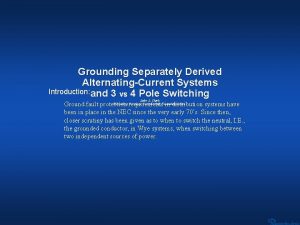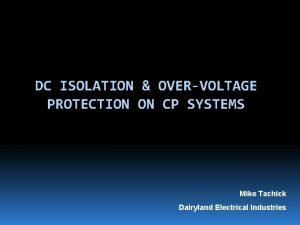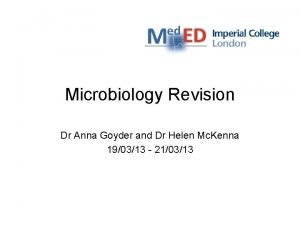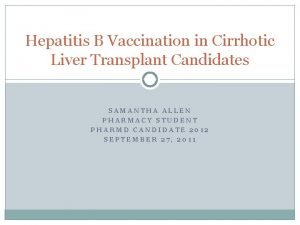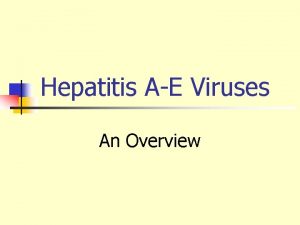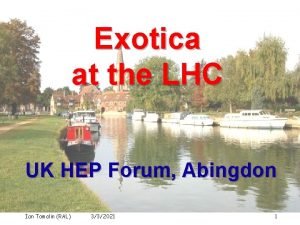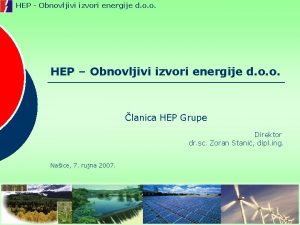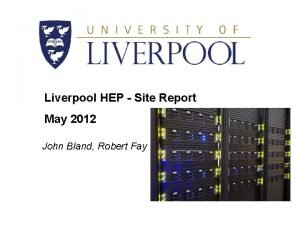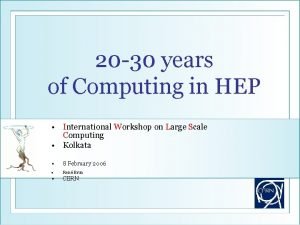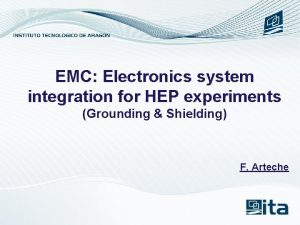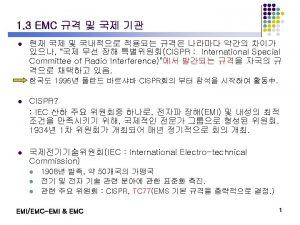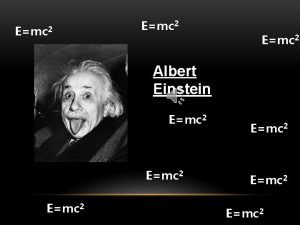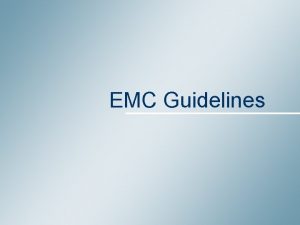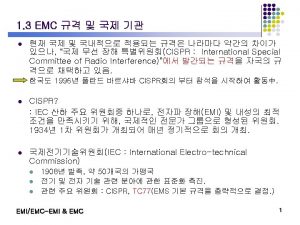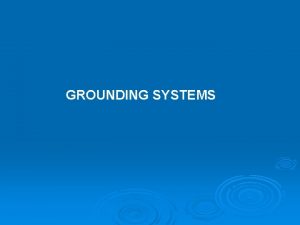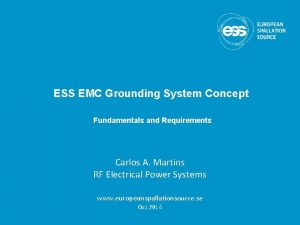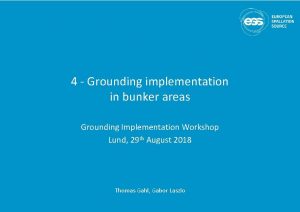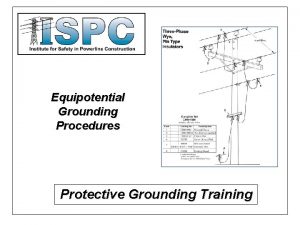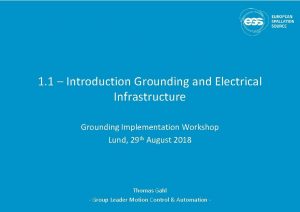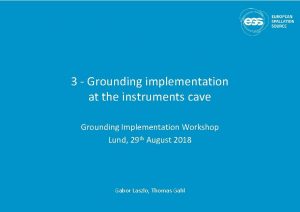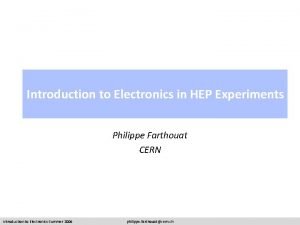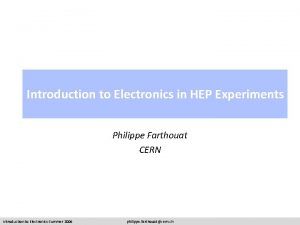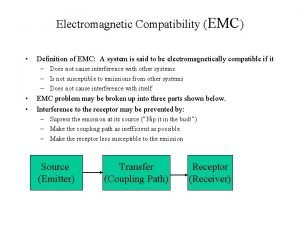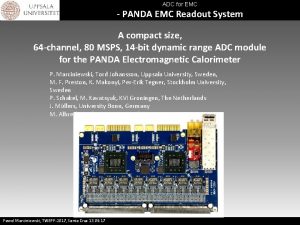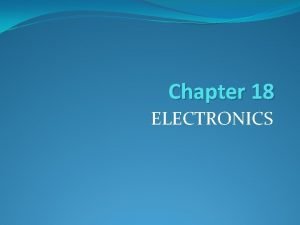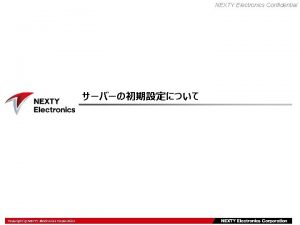EMC Electronics system integration for HEP experiments Grounding
























- Slides: 24

EMC: Electronics system integration for HEP experiments (Grounding & Shielding) F. Arteche

OUTLINE • • 1. EMC integration strategy 2. Grounding 3. Block diagram (EMC map) 4. EMC unit analysis – Noise emissions – Noise immunity – Coupling path • Cabling coordination • 5. Conclusions 1 de 23 10 th Open Meeting of the Belle II Collaboration November 15 th -20 th , 2011, KEK, Japan

1. EMC integration strategy • The main goal is to ensure the correct performance of HEP detectors or experiments. – Ensure the compatibility in each sub-system – Ensure the compatibility among units – sub-systems • It establishes a safety margin • EMC integration strategy is carried out in three stages: – Grounding issues (strategy) – Block diagram (EMC map) – EMC unit analysis Compatibility SUB 1 2 de 23 SUB 2 10 th Open Meeting of the Belle II Collaboration November 15 th -20 th , 2011, KEK, Japan Compatibility

1. EMC integration strategy • It applies TOP-BOTTON-TOP approach – Detector-Sub-system-EMC unit – EMC unit identification – Minimum unit that represents each sub- system • EMC unit analysis is carried out by – Identification & evaluation of noise sources – Identification & evaluation of noise immunity at FEE level – Identification & evaluation of coupling paths • The identification & evaluation are based on : – Standardized measurements – Non- standardized measurements – Electromagnetic models (simulation) 3 de 23 10 th Open Meeting of the Belle II Collaboration November 15 th -20 th , 2011, KEK, Japan

2. Grounding • What is a ground ? – It is a reference • Uniform reference voltage at any frequency – It is a structure to bypass currents • Fault (short circuits. . ) • Noise • Reasons for Grounding – Safety – Equipment protection – Equipment performance • Golden rule: – “Make the system safe and then make it work ” 4 de 23 10 th Open Meeting of the Belle II Collaboration November 15 th -20 th , 2011, KEK, Japan

2. Grounding • Recommendation for good grounding designs: – Selection of reference structure ( grid 3 D or plane) • Detector & Experiment level – Safety ground & equipment protection • Laboratory codes and standards. – Ground designs to improve the equipment performance • At LF – Avoid ground loops • At HF – Avoid noise currents pass through sensitive parts – All experiment subsystems have to present the same ground topology. • They have to be coordinated 5 de 23 10 th Open Meeting of the Belle II Collaboration November 15 th -20 th , 2011, KEK, Japan

2. Grounding 6 de 23 Experiment level 10 th Open Meeting of the Belle II Collaboration November 15 th -20 th , 2011, KEK, Japan

2. Grounding System level Courtesy : Dr. Rivetta (SLAC) Global & System grounding policy have to be coordinated 7 de 23 10 th Open Meeting of the Belle II Collaboration November 15 th -20 th , 2011, KEK, Japan

3. Block diagram (EMC map) • The block diagram is used to : • • Identify sub-systems Power levels Noise sources and victims Coupling phenomena • It helps to define the EMC unit • All studies and analysis will be focused on this unit to ensure the correct electronics integration 8 de 23 10 th Open Meeting of the Belle II Collaboration November 15 th -20 th , 2011, KEK, Japan

3. Block diagram (EMC map) Tracker Slow control 2. 5 V, 1. 25 V 500 V Radiation Noise Transients Conductive Noise Distribution Bus (AC) Harmonics Radiation Noise AC-DC Radiation Noise SMPS AC-DC FEE (dc) Radiation Noise FEE (dc) SMPS Radiation Noise Conductive Noise HCAL • CMS EMC map – Block diagram 6. 5 V, 4. 5 V 7 k. V 9 de 23 Conductive Noise 10 th Open Meeting of the Belle II Collaboration November 15 th -20 th , 2011, KEK, Japan Slow control Shielding

4. EMC unit analysis • HEP experiments are very complex • The idea is to define general rules emerging from particular sub-systems (TOP-BOTTON-TOP approach) • HEP sub-detectors can be considered as isolated system – Power Supply & Slow control system only galvanic connection. • A reduced model of the sub-system is considered for EMC study of HEP experiment – Noise sources – PS – Coupling path - Cables – Victim - FEE P. S. Noise source 10 de 23 Voltage Distribution Coupling path Victim FEE Detector Optical Link 10 th Open Meeting of the Belle II Collaboration November 15 th -20 th , 2011, KEK, Japan

4. EMC unit analysis • HCAL EMC FEE unit – 1 RBX – Two boards connected – PCB • Preshower FEE unit – 1 Leader – 7 Modules • TEC FEE unit – 1 Petal – Petal divided in – Rings & Modules (16) – ICB- Inter Circuit Board 11 de 23 10 th Open Meeting of the Belle II Collaboration November 15 th -20 th , 2011, KEK, Japan

4. 1 EMC unit analysis: Noise emissions • One of the most important noise sources in HEP are the switching power supplies. • They have EM emissions – Radiated – Conducted Emissions • Frequency range – Conducted emissions – few k. Hz up to MHz – Radiated emissions –MHz up to 1 GHz • The spectra content is very close related to : – Switching frequency – Topology • The emissions level of the power supply has to be coordinated: – Sub-detector level – Experiment level 10 th Open Meeting of the Belle II Collaboration 12 de 23 November 15 th -20 th , 2011, KEK, Japan

4. 1 EMC unit analysis: Noise emissions PS 1 PS 2 HS - Electroncis ZCS • All levels are compatible to its system • But they may be not compatible among them. • Different spectra content 13 de 23 PS 3 HS 10 th Open Meeting of the Belle II Collaboration November 15 th -20 th , 2011, KEK, Japan • Hard switching • HF higher • PS Electronics • Increases noise

4. 1 EMC unit analysis: Noise emissions • Several power supplies increase the noises – Test on simple units may not guarantee the performance of final system and experiment – It is necessary to define a safety margin between emission and susceptibility levels. PS 2 (1 unit Vs 50 units) • This is not the only noise source. • Beam pipe & other sub-detectors 14 de 23 10 th Open Meeting of the Belle II Collaboration November 15 th -20 th , 2011, KEK, Japan

4. 2 EMC unit analysis: Noise immunity • But. . Are the PS noise emissions (or other) compatible with the FEE ? ? – Do we have enough safety margin ? • Noise sources that deteriorates the FEE performance are: – Intrinsic thermal noise – EM noise picked-up by the connection detector - FEE – EM noise picked-up by the connection FEE - Power supply • This noise defines the minimum signal level that the FEE can process – Thermal noise dominant effect – Design – Minimize Thermal noise – Characterize the EMI contributions and decrease its effects • The characterization of EMI contributions may be carried out via : – Modeling and simulation of system – Immunity tests on prototypes 15 de 23 10 th Open Meeting of the Belle II Collaboration November 15 th -20 th , 2011, KEK, Japan

4. 2 EMC unit analysis: Immunity- Test • The main goal is to define the immunity of the FEE to RF disturbances – – – Diagnosis Detection of sensitive areas FEE frequency response to noise Evaluate solutions Noise emission specification from PS • Inject a perturbing signal to the FEE and evaluate the FEE performance – Frequency range (k. Hz up to 50 MHz or more) – Test layout ( EMC unit) as similar as possible to the final configuration • Many test configurations may be studied – Shield currents – CM and DM currents – Power lines & slow control lines • Test performed on the FEE: EMC unit FEE 16 de 23 10 th Open Meeting of the Belle II Collaboration November 15 th -20 th , 2011, KEK, Japan

4. 2 EMC unit analysis: Immunity- Test HCAL Pre-shower • Diagnosis & Sensitive areas – HCAL – Ground connection photodiodes-Board – Pre-shower - Ground connections between paths 17 de 23 10 th Open Meeting of the Belle II Collaboration November 15 th -20 th , 2011, KEK, Japan

4. 2 EMC unit analysis: Immunity- Test • Frequency response – It is the noise transfer function (TF) of FEE • To quantify the sensibility of the FEE to noise currents Icm External Noise TF Vout (RMS) • The FEE is very sensitive at high frequency, above the amplifier bandwidth • 18 de 23 10 th Open Meeting of the Belle II Collaboration November 15 th -20 th , 2011, KEK, Japan The noise coupling path is important at HF.

4. 2 EMC unit analysis: Immunity- Test • FEE susceptibility level coordination: – The pre-shower FEE system showed poor results but they were in early stage of the design • Corrective action were implemented (New filtering) – Allowed to identify the system that needed to improve the design 19 de 23 10 th Open Meeting of the Belle II Collaboration November 15 th -20 th , 2011, KEK, Japan

4. 3 EMC unit analysis: Coupling path • Any HEP experiment have a large amount of cables installed in a small volume. • These cables are very different – Voltages - LV (V ) to HV (k. V) – Currents - Low currents (ma) to High Currents (several amps) – Signal & power • Attention should be paid in the cabling coordination because it may lead to some integration problems. – Interference phenomena • High frequency – Transient effect • Low frequency phenomena – Destructive effects • The coupling path analysis can be carried out using: – Numerical simulation programs – Real measurements 10 th Open Meeting of the Belle II Collaboration 20 de 23 November 15 th -20 th , 2011, KEK, Japan

4. 3 EMC unit analysis: Coupling path • A transient phenomena in HV line may generate a transient in the LV • Short circuit in HV lines – High current • The HV capacitor is discharged • HV PS reacts fast 21 de 23 10 th Open Meeting of the Belle II Collaboration November 15 th -20 th , 2011, KEK, Japan

4. 3 EMC unit analysis: Coupling path • A Pspice simulation shows an overvoltage in the LV line. • LV-PS cannot attenuates this transient • Transient energy depends on : • Design parameters – HV capacitor & LV protection • Cabling integration – Cable layout and organization (power levels) • This is a simulation but during a RAD test of power system we observed this effect. 22 de 23 10 th Open Meeting of the Belle II Collaboration November 15 th -20 th , 2011, KEK, Japan

5. CONCLUSIONS • The electronics integration activities are important to ensure the correct performance of any HEP • The electronics integration of HEP experiment is defined by grounding and shielding issues – They will define the emission and susceptibility of any system to EM noise • Front-end Electronics susceptibility • Emission of electronic equipment • The coordination of these items is very important to ensure the correct performance of the experiment – An small and well coordinated team is the best option • One experienced person per sub-detector • They have to take decisions, coordinate, fix noise level and responsibilities 23 de 23 10 th Open Meeting of the Belle II Collaboration November 15 th -20 th , 2011, KEK, Japan
 Grounding system design
Grounding system design Grounding separately derived systems
Grounding separately derived systems Non separately derived system grounding diagram
Non separately derived system grounding diagram Tower grounding system training
Tower grounding system training Decoupling from utility grounding system
Decoupling from utility grounding system Abcdl gram positive rods
Abcdl gram positive rods Dalmatur
Dalmatur Hep b vaccine schedule for adults
Hep b vaccine schedule for adults Chronic hepatitis
Chronic hepatitis Hep c results interpretation
Hep c results interpretation Hcv symptoms female
Hcv symptoms female Uk hep forum
Uk hep forum Nucloplasm
Nucloplasm Hep obnovljivi izvori energije
Hep obnovljivi izvori energije Hep b vaccines
Hep b vaccines Www.cdc.gov/vaccines/schedules/index.html
Www.cdc.gov/vaccines/schedules/index.html Hepatitis b causes symptoms and treatment
Hepatitis b causes symptoms and treatment Termoelektrana sisak
Termoelektrana sisak Liverpool hep c
Liverpool hep c Hep international
Hep international Three dimensions of corporate strategy
Three dimensions of corporate strategy Forward and backward integration
Forward and backward integration Integration
Integration Differentiate between dry docking and grounding
Differentiate between dry docking and grounding Job card grounding
Job card grounding

